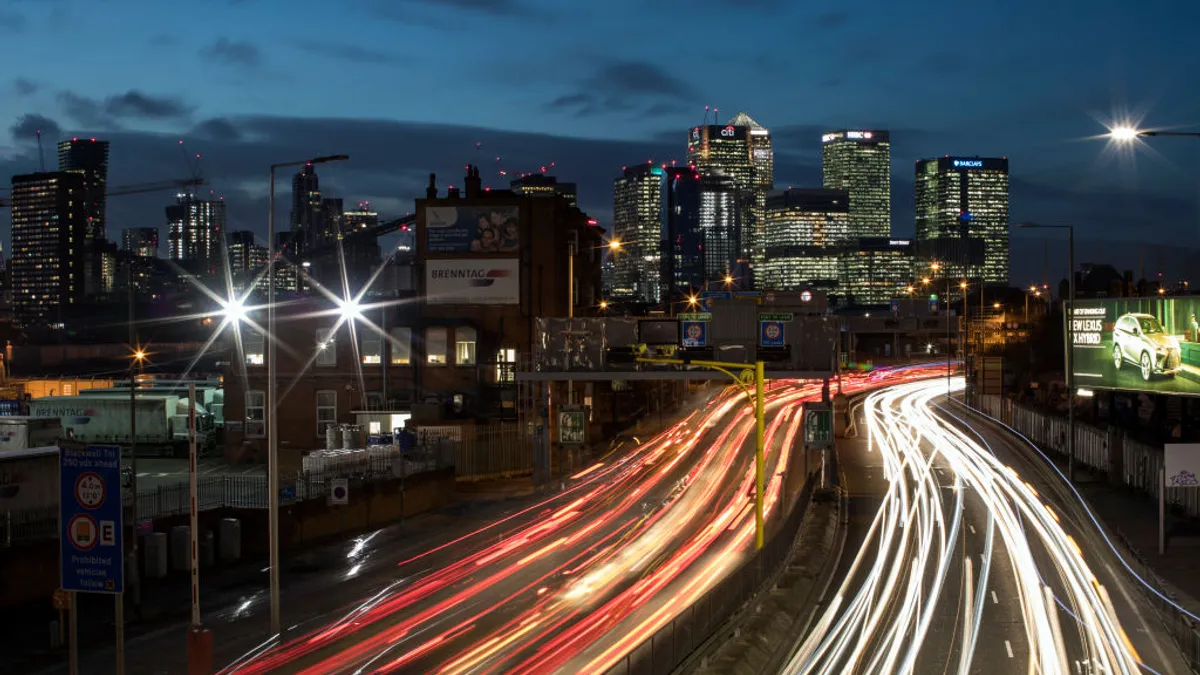UPDATE: March 4, 2022: London Mayor Sadiq Khan announced Friday that he's calling on the city's transport authority to expand the experimental Ultra Low Emission Zone citywide in 2023. Such a change would remove up to 40,000 of the most polluting cars from London's roads each day, according to the announcement. It also cited a report last month saying London must cut car traffic by at least 27% by the end of the decade to achieve net-zero carbon emissions by 2030. The shift will require more walking and cycling, as well as an uptick in public transportation use and cleaner vehicles, Khan said, and a smarter, simpler road-user fee structure so that drivers' costs vary based on mileage, traffic congestion, how polluting a vehicle is and other factors.
Dive Brief:
- Emissions standards for heavy-duty vehicles driving through Greater London have led to more widespread use of clean trucks, which is likely providing air quality benefits across much of England and Wales, according to a new report from INRIX and Environmental Defense Fund (EDF) Europe.
- Vehicles operating in London’s Ultra Low Emission Zone (ULEZ), which launched in 2019, must meet certain emissions standards or pay a fine. In March 2021, London Mayor Sadiq Khan tightened the emissions restrictions of a much larger Low Emission Zone (LEZ) that covers most of Greater London to require commercial trucks and similar vehicles over 3.5 metric tons and buses and vans over 5 metric tons operating there to meet the ULEZ emissions standards for nitrogen oxides. Together, the two zones comprise Greater London's Clean Air Zone.
- Heavy-duty vehicles that drive through Greater London's Clear Air Zone travel an average of twice as much distance outside of it as they do inside of it, according to the EDF and INRIX analysis, giving the regulation a wider geographic impact. With heavy fleet turnover because of the restrictions, The analysis estimates that up to 18 million more people may see air quality benefits from the Clean Air Zone.
Dive Insight:
Since London launched its ULEZ in 2019, several other cities in England have adopted or announced similar plans for clean air zones. Although no U.S. cities have instituted their own clean air zones, New York has explored congestion zones, while other cities are turning over municipal fleets to electric vehicles.
London’s scheme has shown significant air quality benefits. Within the first six months, air pollution linked to traffic dropped by more than a third in central London, according to a city report. As of May 2021, nitrogen dioxide emissions in that area were also almost halved.
Mayor Khan has announced plans to make the Ultra Low Emissions Zone 18 times larger in October.
The announcement of restrictions and fines has led to rapid fleet turnover. At the end of 2020, more than 92% of heavy-goods vehicles that would drive through London met the new standards, according to EDF. In April, the UK recorded its highest ever monthly volume of new vans registered, according to the Society of Motor Manufacturers and Traders. That fleet turnover extends the pollution reduction benefits well beyond the city center, the EDF analysis found, based on traffic data from September 2019 that reflected a pre-pandemic routine.
"Although these zones are deployed locally, our new data analysis reveals how the true 'reach' of Clean Air Zones goes far beyond their boundary — likely bringing air quality benefits to millions of people in London and across the country," wrote Oliver Lord, head of policy and campaigns for EDF, and Greg Slater, EDF senior data analyst, in a blog post.
In 2021, Santa Monica launched the United States' "first of its kind" voluntary zero-emissions delivery zone, a one-square-mile zone where delivery companies are encouraged to use electric or low-emission vehicles. The Los Angeles Cleantech Incubator, which helped create the zone, also recently received a federal grant to explore zero-emission delivery and electric vehicle use by commercial fleets in LA and efforts to bring commercial curb management to encourage low-emission trucks and explore clean trucks in other cities.
Patricio Portillo, a transportation analyst with the Natural Resources Defense Council, said the heavy-duty sector is a key target for reducing transportation emissions, especially given the relative lack of new vehicles compared with progress in the passenger car sector. While there is high demand from fleet companies, Portillo said, "that hasn’t been met with supply," meaning more regulations and incentives may be necessary.
California adopted the nation’s first manufacturing and sales requirements for zero-emission trucks last year, which requires that truck makers sell an increasing percentage of electric or clean fuel trucks instead of diesel and gasoline vehicles. New Jersey has adopted the rule, and other states — including Oregon and Massachusetts — are exploring it as well. California also has a separate rule requiring that trucks cut emissions by 90% by 2027, and the Biden administration is working on tighter emission rules for trucks.
Even if fleets start turning over, Portillo said, it will be important for cities to look at where those vehicles drive to make sure the emission reductions reach urban residents who may be hardest hit by traffic fumes. The Delivering Zero Emissions Communities program, which includes NRDC and backing from the Zero Now Fund, recently awarded three cities assistance, including technical work on charging infrastructure and fleet turnover, to achieve 100% zero emission commercial vehicles by 2030.
"Cities have a strong incentive to make sure these vehicles reach their roads," Portillo said. "There’s such a big range, from contractor pick-up trucks to 18-wheelers, and cleaning up the types of vehicles in each city is critical."











